Kanchi Kailasanathar Temple
The Kanchi Kailasanathar temple is the oldest structure in Kanchipuram.[1] Located in Tamil Nadu, India, it is a Hindu temple in the Tamil architectural style. It is dedicated to the Lord Shiva, and is known for its historical importance. The temple was built from 685-705 AD by a Rajasimha (Narasimhavarman II) ruler of the Pallava Dynasty. The low-slung sandstone compound contains a large number of carvings, including many half-animal deities which were popular during the early Pallava architectural period.[2] The structure contains 58 small shrines which are dedicated to various forms of Shiva. These are built into niches on the inner face of the high compound wall of the circumambulatory passage.[3] The temple is one of the most prominent tourist attractions of the city.[4]
| Kanchi Kailasanathar Temple | |
|---|---|
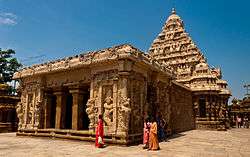 Kanchi Kailasanathar Temple | |
| Location | Kanchipuram, Tamil Nadu, India |
| Coordinates | 12.842311°N 79.689573°E |
| Built | 685-705AD |
| Architect | unknown, but commissioned by Narasimhavarman II |
| Architectural style(s) | Pallava architecture (Pallava) |
| Type | Cultural |
| State Party | |
 Location in Tamil Nadu, India | |
Geography
The temple is located on the banks of the Vegavathy River at the western limits of the Kanchipuram. It faces east.[5][6] Its location, demarcated according to the religious faiths, is in one of three "Kanchis", the Shiva Kanchi; the other two Kanchis are, Vishnu Kanchi and Jain Kanchi.[7] It is 75 kilometres (47 mi) from the Chennai, the capital city of Tamil Nadu.[7] Kailasanathar is one of several notable temples in Kanchipuram, the others being Ekambaranatha, Kachapeshwarar, Kamakshi Amman, Kumarakottam Temple, and Varadaraja Perumal.
History

The Kailasanathar Temple (meaning:"Lord of the Cosmic Mountain"), is built in the tradition of Smartha worship of Shiva, Vishnu, Devi, Surya (Sun), Ganesha and Kartikeya, in Hinduism, a practice which replaced Buddhism.[8]
Temple construction is credited to the Pallava dynasty, who had established their kingdom with Kanchipuram (also known as "Kanchi" or "Shiva Vishnu Kanchi") as the capital city, considered one of the seven sacred cities under Hinduism. In Kanchi, after the Pallavas expanded their territories to the north, west and south both within Tamil, Andhra and Kannada territories under Emperor Narasimhavarman I, they started expanding their capital city of Kanchipuram and built many temples of great magnificence. Among the two unique specimens of temple architecture of the period 640-730 AD are the Tiru Parameswara Vinnagaram, which is also known as the Vaikunta Perumal temple and the Kailsahanathar Temple.[5]
The temple was built during 685-705AD.[9] It is the first structural temple built in South India by Narasimhavarman II (Rajasimha), and who is also known as Rajasimha Pallaveswaram. His son, Mahendravarman III, completed the front façade and the gopuram (tower). Prior temples were either built of wood or hewn into rock faces in caves or on boulders, as seen in Mahabalipuram.[3][7] The Kailasanathar temple became the trend setter for other similar temples in South India.[10] According to local belief, the temple was a safe sanctuary for the rulers of the kingdom during wars. A secret tunnel, built by the kings, was used as an escape route and is still visible.[3] It is believed that Raja Raja Chola I (985–1014 CE) visited the temple and drew inspiration from this temple to build the Brihadeeswara Temple.[11]
Currently, Kanchi Kailasanathar Temple is maintained by Archaeological Survey of India.[12]
Architecture
| Wikimedia Commons has media related to Kanchi Kailasanathar Temple. |

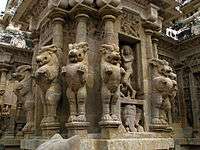

The temple has retained the Pallava architecture in its original stylized form with influence of the later styles developed by the Chola Dynasty and Vijayanagara Emperors.[3] It is of stone built architecture unlike the rock cut architecture built into hallowed caves or carved into rock outcrops as in Mahabalipuram. The tall gopuram (tower) is to the left and the temple complex is to the right.[13] The temple's foundations are made of granite, which could withstand the weight of the temple, while the superstructure, including the carvings, are all made of sandstone. Initially, only the main sanctuary existed with pyramidal vimana and a detached mandapa (main hall).[14]
The temple complex is complete in all respects as it has garbagriha (sanctum sanctorum), antarala (inner enclosure), mandapa, a high compound wall, and an entrance gate, the gopuram.[12] The mandapa, which was initially detached, was made part of the main shrine by interposing an ardhamantapa (smaller hall). The pillars of the mandapa have the repetitive features of mythical lion mounts.
The structure has a simple layout with a tower or vimana at the center of the complex. The vimana of the temple, above the main shrine (sanctum sanctorum), is square in plan and rises up in a pyramidal shape. The tower has many levels rising proportionately.At the top of this tower, there is a small roof in the shape of a dome. The pillar elements with mythical animal shapes (lions on the base) are extra features in Pallava style.[12][5] At the entrance, the gopuram walls are plastered. Its entrance wall has eight small shrines and a gopura, precursor to the main gopura. At some later stage, the mandapa and the sanctuary were joined by an intermediate hall called the ardhamantapa, which is reported to have marred the beauty of the temple to some extent. The temple is enclosed within walls in a rectangular layout.
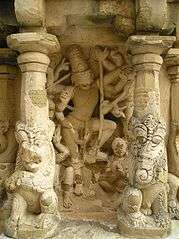
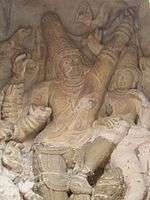
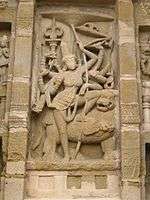
The main shrine has a 16 sided Shivalinga in black granite stone deified in the sanctum sanctorum. Within the walls of the main shrine there is padabhanda adhisthana (main pedestal) with very elegantly carved images of gods with a sculpted Nandi, a little distance away giving guard to the deity. On each face of the outer walls of the main shrine there are many carvings of deities.
In the south facing wall the sculpture depicts Shiva as Umamaheshavara (Shiva with his consort Parvati) with Lingodbhava (emergence of Shiva as fiery pillar - linga) surrounded by Brahma and Vishnu and flying amaras on the lower level.
The west facing hall has sculptures of Shiva in the form of Sandhya Tandavamurti and Urdhava Tandvamurti and the ensemble is completed with images of ganas in dancing poses and also with images of Brahma, Vishnu, Nandi and Parvati.
The carving of Shiva on the north facing wall is a composition of Tripurantaka flanked by three ganas, goddess Durga with three ganas, and goddesses Bhairavi, Kaushiki and Jyestha.
The exterior faces of the vimana (tower) have images of aspects of Shiva - Bhikshatana, Somaskanda and in Samhara-Tandava (destructive dancing) pose.
In the inner walls of the prakara (circumambulatory passage) there is galaxy of images of Durga, Kartikeya, Bhavati, Tripurantaka, Garudarudha-Vishnu, Asura Samhara (slaying of demons), Narasimha (Vishnu's avatar), Trivikrama (another Vishnu's avatar), Shiva Tandava (Shiva in a dancing pose), Shiva severing the fifth head of Brahma, desecration of Yagna of Daksha, Brahma and his wife, Gangadhara, Urdhava tandava, Vishnu flanked by Bhudevi and Sridevi, Lingodbhava, Bhikshatana, Ravana, and Vali offering prayers to Atmalinga Chandikeshvara. The image of Ardhanariswara sitting on a bull is considered the most noteworthy among all images.[15]
Vimana's south facing wall has very elegant image of Shiva in a sitting posture of peace and quietude known as Dakshinamurthy, and its west wall has Shiva in the form of Lingodbhava.
The tower has multiple shrines embodied on all its external faces which have the appearance of miniature shrines. These shrines have three features, the sala (rectangular), kuta (square) and panjara (apsidal) styles. Eight small shrines also decorate the entrance wall. The 58 small shrines are built into the niches of the compound wall that encloses the main shrine; they depict Somaskanada reliefs of Shiva and his consort Parvathi in many dance forms.[3]
The temple maybe built using a geopolymer that looks like sandstone.[16]
Other features
The outstanding feature of sculptures is the profusion of depiction of the erect lions projecting out in several directions.[10]There are two sculptures of Shiva here which are seen holding the Veena (musical string instrument) in the hand. There is a lot of difference between the Veena found in the said sculptures and the present day Veena.[17] There are also beautiful sculptures of Mathahvialasa Prakshanam. The temple also has the earliest stone inscription which records of the twenty eight Saivagamas (Shaiva saints) in which the Pallava King Rajasimhavarman states his faith in Shaivism.[18] The murals on the inner walls are well preserved.[7]
Circumambulatory passage
A circumambulatory passage, with a symbolic meaning is situated along the compound wall. In order to make the circumambulation, there is a narrow entry passage which devotees must crawl through. Seven steps must be climbed in order to reach the passage. Passing through the narrow passage is indicative of passage through life. After the circumambulation, the exit is through a pit or another narrow passage symbolic of death. [7][19] The entry point for this passage is called Gate of Death (Tamil: இறப்பு வாசல்). It is believed that making the circumambulation round the various deities would usher the same blessings as visiting paradise.During completion of circumambulation - Crawling and coming out of the passage also indicates that your coming out of mother's womb and also explains Hindu's belief of rebirth. Hence, exit is called Gate of Birth (Tamil: பிறப்பு வாசல்). There is another belief that by completing this circumambulatory passage the possibility of rebirth is not there and you shall attain Moksha. Such passage is UNIQUE, explaining the life cycle including aging process, death and rebirth.
Festival
Maha Shivaratri is the biggest festival held in the temple when thousand of devotees throng the temple in the evening hours to offer prayers to the main deity.[3]
References
- Dobbie 2006, p. 111.
- Singh 2007, p. 145.
- "Kailasanathar Temple". National Informatics Centre of Government of India. Retrieved 27 July 2013.
- Gopal 1990, p. 175.
- Ring, Salkin & La Boda 1996, p. 435.
- Selby & Peterson 2008, p. 109.
- Subburaj 2006, p. 33.
- Rao 2008, p. 96.
- Ninan 2008, p. 132.
- DK Publishing 2009, p. 11.
- Diwakar, Macherla (2011). Temples of South India (1st ed.). Chennai: Techno Book House. p. 142. ISBN 978-93-83440-34-4.
- "General features of a Chola temple". National Informatics Centre of Government of India. Retrieved 27 July 2013.
- Rao 2008, p. 93.
- Rajarajan, R.K.K. "The Iconography of the Kailāsanātha Temple - Seeing beyond the replastered Images and Yoginīs". Cite journal requires
|journal=(help) - V., Meena (1974). Temples in South India (1st ed.). Kanniyakumari: Harikumar Arts. p. 46.
- Vedamuthu, Ranee. "Conservation of a Sandstone Monument at Kanchipuram, Tamilnadu, India" (PDF).
- Leela 1976.
- Raj 1989.
- DK Publishing 2011, p. 582.
Bibliography
- DK Publishing (21 December 2009). Great Monuments of India. DK Publishing. ISBN 978-0-7566-6561-6.CS1 maint: ref=harv (link)
- DK Publishing (1 September 2011). DK Eyewitness Travel Guide: India. DK Publishing. ISBN 978-0-7566-8444-0.CS1 maint: ref=harv (link)
- Dobbie, Aline (2006). India: The Elephant's Blessing. Melrose Press. ISBN 978-1-905226-85-6.CS1 maint: ref=harv (link)
- Gopal, Madan (1990). K.S. Gautam (ed.). India through the ages. Publication Division, Ministry of Information and Broadcasting, Government of India. p. 217.CS1 maint: ref=harv (link)
- Leela, S. V. (1976). Veena, self-taught: an introduction to Carnatic music. S.l. : s.n.CS1 maint: ref=harv (link)
- Ninan, M.M. (23 June 2008). The Development Of Hinduism. Madathil Mammen Ninan. ISBN 978-1-4382-2820-4.CS1 maint: ref=harv (link)
- Raj, Joseph Jaswant (1989). Grace in the Saiva Siddhāntham and in St. Paul: A Contribution in Inter-faith Cross-cultural Understanding. South Indian Salesain Society. ISBN 978-81-900092-0-1.CS1 maint: ref=harv (link)
- Rao, P. V. L. Narasimha (2008). Kanchipuram: Land of Legends, Saints and Temples. Readworthy. ISBN 978-81-89973-54-4.CS1 maint: ref=harv (link)
- Ring, Trudy; Salkin, Robert M.; La Boda, Sharon (January 1996). International Dictionary of Historic Places: Asia and Oceania. Fitzroy Dearborn Publishers. ISBN 978-1-884964-04-6.CS1 maint: ref=harv (link)
- Selby, Martha Ann; Peterson, Indira Viswanathan (2008). Tamil Geographies: Cultural Constructions of Space and Place in South India. SUNY Press. ISBN 978-0-7914-7945-2.CS1 maint: ref=harv (link)
- Singh, Sarina (2007). South India (4th ed.). Lonely Planet. ISBN 9781740594219.CS1 maint: ref=harv (link)
- Subburaj, V.V.K., ed. (2006). Tourist Guide to South India. Sura Books. ISBN 978-81-7478-175-8. Retrieved 30 July 2013.
External links
| Wikimedia Commons has media related to Kanchi Kailasanathar Temple. |
Gallery
 Main entrance
Main entrance Front mandapa
Front mandapa Temple inner view (right)
Temple inner view (right) Vimana (right)
Vimana (right) Temple inner view (left)
Temple inner view (left) Temple outer view (left)
Temple outer view (left) Entrance and Vimana
Entrance and Vimana Temple outer view (right)
Temple outer view (right)